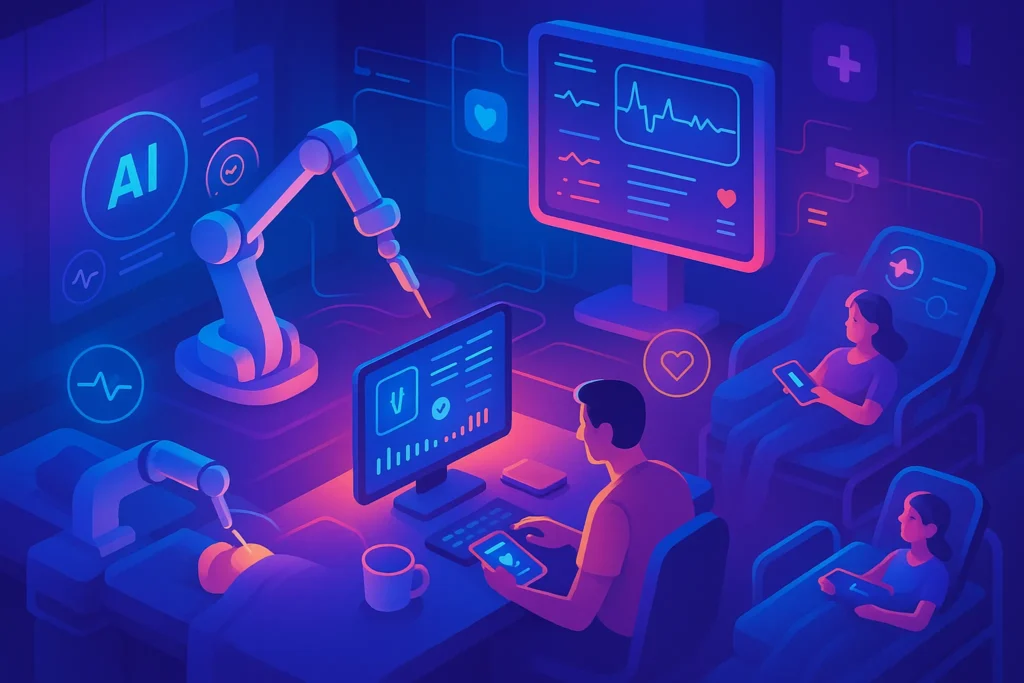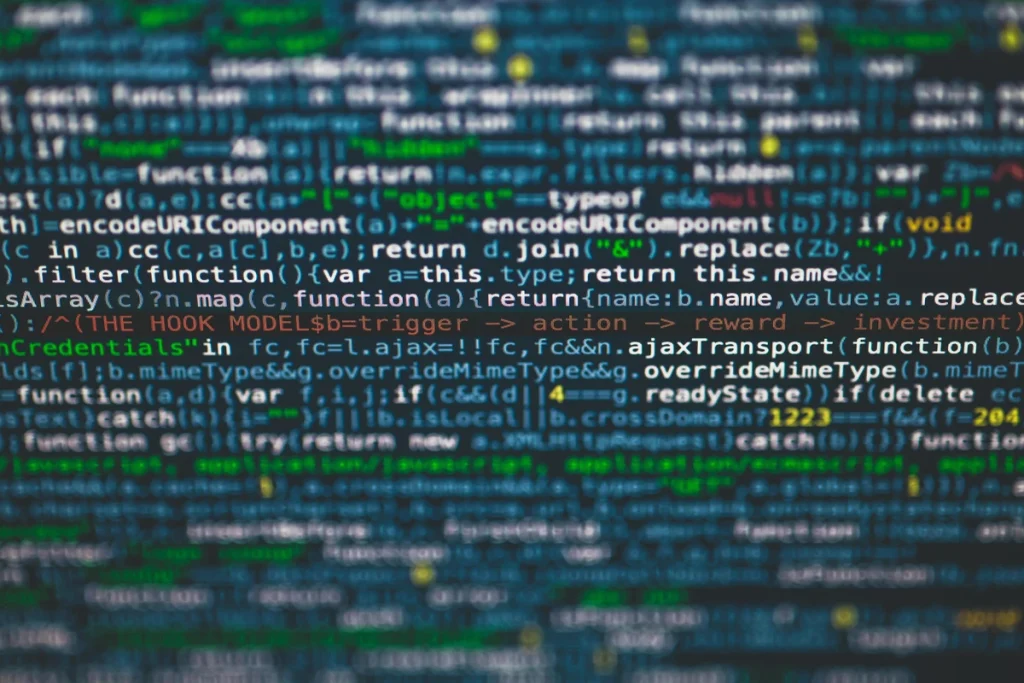🚨 Introduction: From Code to Cure
Artificial Intelligence is no longer just a futuristic concept — it’s operating in emergency rooms, radiology labs, pharmaceutical pipelines, and even in robotic arms performing surgery. AI is changing how we diagnose, treat, and manage health.
In this deep dive, we explore how AI is revolutionizing healthcare — not just in theory but in real-world applications already saving lives today. From AI-assisted diagnosis and accelerated drug discovery to predictive hospital analytics and surgical robots, this is how data becomes healing.
🧬 AI in Diagnostics: Faster, Smarter, More Accurate
One of the most impactful uses of AI in medicine is in diagnostic accuracy. Trained on millions of medical images and cases, AI models can detect patterns invisible to the human eye — leading to earlier and more reliable diagnoses.
Examples:
-
PathAI uses machine learning to identify cancer in pathology slides with accuracy rates that rival top human pathologists.
-
Aidoc analyzes radiology images in real-time, alerting doctors to conditions like brain bleeds or pulmonary embolisms before it’s too late.
AI in diagnostics doesn’t just automate — it enhances clinical decision-making. And in many cases, it buys time. In healthcare, time saves lives.
This builds upon what we explored in AI in Healthcare: Breakthroughs and Challenges and ties into broader patterns discussed in Emerging AI Trends.
💊 AI in Drug Discovery: Shrinking the 10-Year Timeline
Traditional drug development takes 10–15 years and billions of dollars. AI dramatically reduces this timeline by predicting molecular interactions, identifying viable drug candidates, and simulating clinical trial outcomes.
Notable Platforms:
-
DeepMind’s AlphaFold cracked the protein-folding problem, unlocking insights into disease mechanisms that once took decades.
-
BenevolentAI uses machine learning to find non-obvious relationships in biomedical data — like repurposing existing drugs for new diseases.
In the battle against diseases like cancer or Alzheimer’s, AI can mean earlier treatment, faster rollout, and more affordable access.
🤖 Robot-Assisted Surgery: Precision Beyond Human Hands
While AI diagnostics interpret images, robotic surgery brings those interpretations to life — with sub-millimeter precision. Robotic arms controlled by surgeons (augmented by AI) can reduce complications and speed up recovery.
Example:
-
The Da Vinci Surgical System is used globally for complex procedures like cardiac, prostate, and eye surgery. AI optimizes instrument movement, reducing fatigue and risk.
It’s not about replacing surgeons — it’s about extending their precision and endurance. Surgical AI tools are like having a second set of steady hands.
Want to understand more about real-time AI on devices like surgical assistants? Our post on Edge AI explains how localized inference is transforming time-critical applications.
📬 Want Weekly Tech That Saves Lives?
Subscribe to our newsletter for in-depth breakdowns of AI innovations in healthcare, smart diagnostics, no-code health tools, and ethical tech debates. No hype — just insights built for creators, founders, and future technologists.
🔐 No spam. No clutter. Just health + tech fused into value-driven content.
📈 Predictive Analytics for Hospitals: Smarter Management, Safer Patients
Beyond diagnostics and treatment, AI is proving essential in how hospitals are managed. With the help of predictive models, healthcare providers can now forecast patient surges, anticipate complications, and optimize resource allocation.
For example, machine learning platforms like Qventus and Jvion analyze historical data and real-time inputs to:
-
Predict ICU admission needs
-
Flag patients at risk of readmission
-
Optimize staffing levels
-
Prevent medicine shortages
These models help hospitals become proactive rather than reactive — improving both patient outcomes and operational efficiency.
In environments where every second and every bed matters, predictive AI allows care teams to plan ahead — not just respond under pressure.
It’s not just care — it’s coordination. And in pandemic scenarios, predictive AI can mean the difference between chaos and control.
⚖️ Ethical Challenges & Bias in Medical AI
As AI becomes embedded in healthcare, critical ethical concerns emerge — especially around fairness, transparency, and control.
Most AI models are only as good as the data they’re trained on. If those datasets lack diversity (e.g., underrepresenting minorities or women), the models may produce biased predictions. For instance, some dermatology AIs underperform on darker skin tones because they were trained mostly on lighter ones.
In addition, many high-performing AI models are “black boxes” — delivering predictions without explainability. For physicians, trust in AI requires transparency.
There’s also the risk of automation bias: over-reliance on machine recommendations without human judgment. In healthcare, that can be dangerous.
The future of medical AI must balance innovation with rigorous ethical guardrails — ensuring equity, clarity, and accountability in every decision made.
📊 Case Study: How AI Saves Time in Cancer Diagnosis
In 2023, Mayo Clinic integrated Aidoc into its emergency radiology pipeline. The result? A 28% increase in early-stage cancer detection, with AI reducing average time-to-diagnosis by over 2.7 hours per patient. In high-risk cases like brain bleeds, that margin is life-saving.
Real-world deployments like this show how AI isn’t a future promise — it’s already functioning in critical hospital infrastructure.
🗣️ Voice-Based AI: The New Frontier
One of the most promising frontiers in AI healthtech is voice analysis. Researchers and startups are now training models to detect disease through subtle changes in vocal patterns, tone, and rhythm.
For example:
-
Neurodegenerative conditions like Parkinson’s and ALS cause tremors in speech long before motor symptoms appear.
-
Mental health issues such as depression and anxiety leave acoustic fingerprints detectable through emotion AI.
-
Respiratory illness like COVID-19 or bronchitis can be flagged through cough and breathing sounds.
Platforms like Sonde Health and university labs (e.g., MIT, Cambridge) are building non-invasive, voice-based diagnostics deployable via smartphone.
Voice is fast becoming a biomarker — a way for doctors (and even apps) to “listen” to your health in ways never before possible.
🌍 Global Perspective: AI as Equalizer in Healthcare
In many developing countries, access to healthcare is limited by location, cost, and shortage of trained professionals. That’s where AI becomes not just a tool of convenience — but of access and survival.
Several innovative initiatives illustrate this:
-
Apollo Hospitals (India) uses AI for mass retinal screening to catch diabetic blindness early.
-
Babyl (Rwanda), a chatbot from Babylon Health, triages patients remotely, helping reduce load on overburdened clinics.
-
Ada Health, based in Germany but multilingual and global, offers free AI-driven symptom checking to millions.
These platforms empower patients with self-assessment, remote triage, and early alerts — even in rural or underserved regions.
In a world of unequal healthcare access, AI can be the great leveler — giving more people, in more places, a chance to be seen, heard, and treated.
🔮 What’s Next in AI-Driven Healthcare?
The next generation of AI in healthcare won’t just analyze data — it will engage with humans in more intelligent, contextual, and empathetic ways.
Here’s what’s on the near horizon:
-
Emotion AI in therapy: detecting distress, frustration, or fatigue in voice or facial cues during remote consultations.
-
AI-powered wearables: passive monitoring of vitals and biomarkers to flag issues before symptoms arise.
-
Smart home assistants with medical triage built-in — like Alexa or Google Assistant integrating health modules.
-
AI as a second opinion engine, helping doctors validate or compare diagnostic paths.
Regulatory frameworks are also evolving fast — meaning more AI tools will soon be FDA-cleared or CE-approved, making them viable for mainstream medical deployment.
The future isn’t just data-driven — it’s context-aware, always-on, and designed to care before the crisis even begins.
If you’re into fitness tracking and early diagnostics, our posts on Fitness Tech and Tech for Health explore the rising role of wearable gadgets.
🔍 Curious Which AI Platforms Are Already Saving Lives?
Explore real-world healthtech tools like Tempus for AI-powered oncology, Babylon Health for virtual triage, and Aidoc for emergency imaging. These aren’t just prototypes — they’re active in hospitals worldwide, enhancing diagnosis and treatment in real time.
→ Visit Tempus | Babylon Health | Aidoc
Affiliate partnerships may apply. We only recommend what we trust.
🧠 Nerd Verdict
The integration of AI into healthcare is no longer theoretical — it’s visible in cancer diagnostics, robotic surgery, ICU planning, and drug research. These innovations aren’t just transforming systems; they’re saving lives, scaling expertise, and democratizing access to advanced care.
But with power comes responsibility. The challenge for the future isn’t just in building better models — it’s in building trust, ensuring privacy, and keeping humans at the center of care.
AI won’t replace your doctor. But it will absolutely upgrade their toolkit — and improve your odds of a healthier future.
❓ FAQ: Nerds Ask, We Answer
💬 Would You Bite?
If your life was saved by an AI diagnosis — would you trust it more than a human doctor?
👇 Tell us in the comments — we’re building the ultimate community-sourced gear guide.



